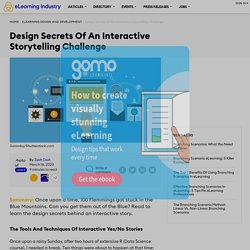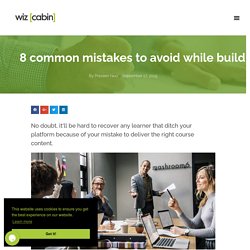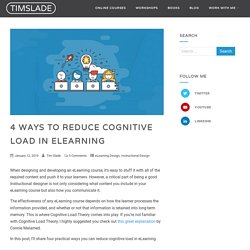

Mayer's 12 Principles of Multimedia Learning. Home - e-Learning kit - Guides at McGill Library. This guide is part infokit, with advice and best practices from the literature, and part toolkit, with links to a number of technologies to explore.

It is divided into three sections: 1) Strategies, 2) Technologies and 2) Bibliography. Strategies is further divided, with an overview for engaging with learning theories, designing for e-learning with the principles of universal design, strategies for building games or gamifying course offerings, and best practices for building community and implementing different technologies. The technologies section covers: learning environments, learning objects, activities, gaming, and building community. UI-Patterns.com. Branching Scenarios: Interactive Storytelling Design. Once upon a rainy Sunday, after two hours of extensive R (Data Science course), I needed a break.

Two things were about to happen at that time: the eLearning Guild's DevLearn conference and an Articulate eLearning Heroes challenge. This article reveals the secrets of building a Yes/No story-based branching challenge using Articulate Storyline. Lesson 7 – Interactive Digital Storytelling (IDS)Techniques – Digital Storytelling & E-Learning Design. While the definitions presented are clearly not an exhaustive list of the definitions that exist for serious games, what is clear though is that serious games, unlike regular video games, go beyond the entertainment factor.

The definition that stands out for me is the one presented by Marsh (2011) as it recognized the multiple approaches (i.e. “digital games, simulations, virtual environments, and mixed reality/media”) that can be used individually or combined to create an educationally sound serious game. What Makes Good eLearning? If I asked you what makes good eLearning, how would you answer?

Would you say instructional design? I’m sure you would—that’s what everyone says! Home - e-Learning kit - Guides at McGill Library. Instructional Design and Templates. Instructional design for flow in online learning. This tutorial describes how the instructional design of an online course can facilitate an optimal learning experience for the student.

The optimal learning experience is the state termed "flow. " Flow, as defined by creativity researcher Mihaly Csikszentmihalyi (pronounced Me-high Chick-zhent-me-high), is the "state in which people are so involved in an activity that nothing else seems to matter; the experience is so enjoyable that people will do it even at great cost, for the sheer sake of doing it.
" During flow experiences, work is pleasure and is rewarding in itself. Csikszentmihalyi has also described flow as "joy, creativity" and " the process of total involvement in life. " The Ultimate eLearning Course Design Checklist. Ensuring that you've crossed off every item, this "to-do" list will allow you to create and implement successful, effective, informative, and practical eLearning courses for learners in both educational and professional settings.

Without further ado, here is an in depth eLearning Course Design checklist that you can use to get your eLearning courses ready for launch: eLearning Course Objectives Have you analyzed the eLearning needs and identified the budget and time constraints? Have all eLearning course audiences been examined and analyzed? Are the eLearning course objectives clear and do they include the criteria for evaluation?
5 Tips for Engaging Online Course Design - The K. Patricia Cross Academy. After years – even decades – of teaching onsite, many instructors are able to teach a traditional, classroom-based course without having laid out the entire course in advance.

This approach doesn’t work well in the online classroom, however, as online course delivery requires more fully developing the course ahead of time. Thus, when teaching online, the process of course design is essential. Online course design requires a wide range of skills and tools and managing both the design and the technical aspects of the course. 7 tips for creating the perfect eLearning design.
This website uses cookies to ensure you get the best experience on our website.

Learn more Got it! 7 tips for creating the perfect eLearning design. 8 Common Mistakes To Avoid While Building e-learning Courses. This website uses cookies to ensure you get the best experience on our website.

Learn more Got it! 8 common mistakes to avoid while building eLearning courses Share on facebook. The #1 eLearning Blog for New eLearning Designers. 4 Ways to Reduce Cognitive Load in eLearning. When designing and developing an eLearning course, it’s easy to stuff it with all of the required content and push it to your learners.

However, a critical part of being a good instructional designer is not only considering what content you include in your eLearning course but also how you communicate it. The effectiveness of any eLearning course depends on how the learner processes the information provided, and whether or not that information is retained into long-term memory. This is where Cognitive Load Theory comes into play. If you’re not familiar with Cognitive Load Theory, I highly suggested you check out this great explanation by Connie Malamed. In this post, I’ll share four practical ways you can reduce cognitive load in eLearning. 6 Key Questions To Effectively Analyze Your eLearning Course Audiences. Developing an eLearning course that offers informative, well written content, and high quality design elements are essential to any successful eLearning project. However, knowing your audience can make the difference between an effective eLearning course and an eLearning course that falls short of expectations (even if you've spent countless hours and resources creating a unique eLearning course).
As such, one of the most invaluable eLearning tasks at your disposal as an Instructional Designer is an eLearning course audience analysis. Top 11 eLearning Mistakes That eLearning Professionals Should Avoid. There are so many things to consider when you're developing an eLearning course. From worrying about the core content and developing an effective eLearning strategy to ensuring that the design is in-line with your organization's brand and message, even the most simple and straightforward eLearning project can become overwhelming. As such, there's plenty of room to make mistakes along the way, whether this is your first eLearning project or your hundredth. Losing sight of the learning goalsThe learning goals should always be in the forefront of your mind. Each and every element of the eLearning course, from the content itself to the seemingly insignificant graphics you use on the final page, should serve those goals. 10 eLearning Design and Development Mistakes - eFront Blog.
In this article, I will list 10 eLearning design and development practices you should avoid while working on your eLearning deliverable. Keeping these practices on-hand, will help you to avoid these common eLearning pitfalls and create deliverables that offer maximum value to your learners. Avoid These Common eLearning Design and Development Mistakes.